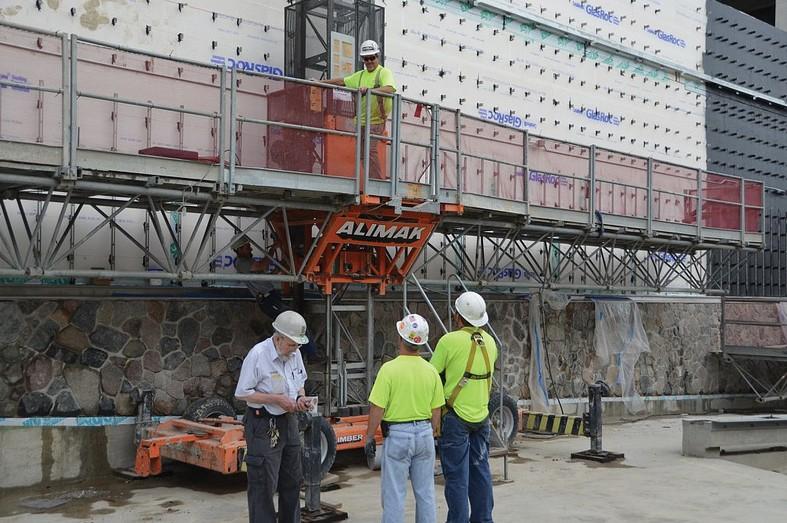New library to be first platinum LEED building on campus

Courtesy Photo / GVSU Library Construction workers discuss the east exterior of the new Mary Idema Pew library.
Nov 7, 2012
The Mary Idema Pew Library, which is due to open in August, is expected to be the first platinum-level LEED building on Grand Valley State University’s campus.
LEED, which stands for Leadership in Energy and Environmental Design, is a consensus-based national standard on high performance and sustainable buildings and was developed by the U.S. Green Building Council.
“The LEED certification reflects the university’s commitment to sustainability in its building program,” said James Moyer, LEED AP and associate vice president for Facilities Planning at GVSU. “It is recognition by an international body that GVSU is constructing facilities that are better than required by minimal standards.”
Moyer added that LEED certified buildings can save money in the long run.
“At GVSU, we find that the cost of owning and operating LEED certified buildings is less than buildings constructed to conventional standards,” Moyer said. “The more efficient buildings lead to less cost for energy (and) water consumption while providing equal or better interior environments.”
LEED was created for several different purposes: to define ‘green building’ by establishing a common standard, promote integrated and whole-building design practices, recognize environmental leadership in the building industry, stimulate green competition, raise consumer awareness of green building benefits, and transform the building market.
LEED is based on scientific standards and provides frameworks upon which to assess building performance and whether the building meets sustainability goals. It also uses state-of-the-art strategies for sustainable development, water conservation, energy efficiency, selection of materials and indoor environmental quality.
The program also offers professional accreditation through four different levels of LEED certification: basic, silver, gold and platinum. The ‘basic’ certification is simply “LEED” certified and means that the building qualifies to be LEED. From there, each level signifies an even greater sustainable building.
According to reedconstructiondata.com, the four levels are determined through a scale of points, which themselves are determined by six categories of sustainability: sustainable sites, worth 14 total points; water efficiency, worth five total points; energy and atmosphere, worth 17 total points; materials and resources, worth 13 total points; indoor and environmental quality, worth 15 total points; and innovation and design process, worth 14 total points.
From there, buildings can earn up to a grand total of 69 points. A rating of 26-32 earns the building a certification. A rating of 33-38 earns a silver certification. A gold certification requires a rating of 39-51, and the platinum certification requires a rating of 52 or higher.
LEED buildings are not rated just on the final product, however. The building process is also taken into account, and effort is made to be sustainable during construction, as well.
“Right now about 90 percent of our debris is diverted away from landfills,” said Scott Veine, director of sustainability for Pioneer Construction, in a statement to GVSU News and Information Services. “On top of that we have dust control, we maintain and monitor our storm water quality which is why we have the chain fence around the perimeter of the work site.” Pioneer is the company GVSU hired to build the new library and is a 76-year-old business that became LEED Certified in 2004. Since then, LEED Certified buildings comprise around 85 percent of its annual projects.
Making buildings LEED certified may sound like it could cost more time and money than it’s worth, but Moyer said that’s not the case.
“We find that constructing to LEED standards has a very minimal impact on a project budget,” he said. “We require the design architect and engineers…to make better choices in materials, design solutions and quality standards. In the construction bidding process, this adds minimal cost.”
GVSU currently has 15 LEED certified buildings and facilities. Of these, four have received LEED gold certification, six have received silver certification, and the Pew Library is expected to be the first platinum certification, bringing the total of certified buildings to 16. As a result, LEED buildings at GVSU total nearly 10 percent of the LEED certifications in the West Michigan area.
For more information on the Mary Idema Pew Library, visit www.gvsu.edu/library/newbuilding.
For more information on LEED buildings and certifications, visit www.reedconstructiondata.com/market-intelligence/green/leed-rating-system.
[email protected]






















